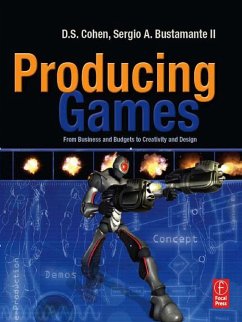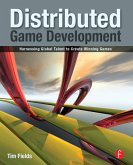Producing Games (eBook, PDF)
From Business and Budgets to Creativity and Design


Alle Infos zum eBook verschenken

Producing Games (eBook, PDF)
From Business and Budgets to Creativity and Design
- Format: PDF
- Merkliste
- Auf die Merkliste
- Bewerten Bewerten
- Teilen
- Produkt teilen
- Produkterinnerung
- Produkterinnerung

Hier können Sie sich einloggen

Bitte loggen Sie sich zunächst in Ihr Kundenkonto ein oder registrieren Sie sich bei bücher.de, um das eBook-Abo tolino select nutzen zu können.
Computer games are big business - tens of billions of dollars are spent annually by the worldwide video games market. The cost of producing video games has ballooned to beyond $20 million dollars in many cases, and team sizes are quickly growing past 100 team members. At the center of this storm is the producer - one person who transforms the money, the hours spent by the team, and the latest technology into a work of art that millions of people will call fun. This book will dig deeply into the role of the producer and expose secrets of game production that stand the test of time: how to build…mehr
- Geräte: PC
- mit Kopierschutz
- eBook Hilfe
- Größe: 2.79MB
![Interactive Storytelling for Video Games (eBook, PDF) Interactive Storytelling for Video Games (eBook, PDF)]() Josiah LebowitzInteractive Storytelling for Video Games (eBook, PDF)41,95 €
Josiah LebowitzInteractive Storytelling for Video Games (eBook, PDF)41,95 €![Tradigital 3ds Max (eBook, PDF) Tradigital 3ds Max (eBook, PDF)]() Richard LapidusTradigital 3ds Max (eBook, PDF)49,95 €
Richard LapidusTradigital 3ds Max (eBook, PDF)49,95 €![Vue 7 (eBook, PDF) Vue 7 (eBook, PDF)]() Ami Chopine & VladimirVue 7 (eBook, PDF)37,95 €
Ami Chopine & VladimirVue 7 (eBook, PDF)37,95 €![Digital Creature Rigging (eBook, PDF) Digital Creature Rigging (eBook, PDF)]() Stewart JonesDigital Creature Rigging (eBook, PDF)51,95 €
Stewart JonesDigital Creature Rigging (eBook, PDF)51,95 €![Action Analysis for Animators (eBook, PDF) Action Analysis for Animators (eBook, PDF)]() Chris WebsterAction Analysis for Animators (eBook, PDF)37,95 €
Chris WebsterAction Analysis for Animators (eBook, PDF)37,95 €![Distributed Game Development (eBook, PDF) Distributed Game Development (eBook, PDF)]() Tim FieldsDistributed Game Development (eBook, PDF)43,95 €
Tim FieldsDistributed Game Development (eBook, PDF)43,95 €![Animated Realism (eBook, PDF) Animated Realism (eBook, PDF)]() Judith KrigerAnimated Realism (eBook, PDF)37,95 €
Judith KrigerAnimated Realism (eBook, PDF)37,95 €-
-
-
Dieser Download kann aus rechtlichen Gründen nur mit Rechnungsadresse in A, B, BG, CY, CZ, D, DK, EW, E, FIN, F, GR, HR, H, IRL, I, LT, L, LR, M, NL, PL, P, R, S, SLO, SK ausgeliefert werden.
- Produktdetails
- Verlag: Taylor & Francis eBooks
- Seitenzahl: 300
- Erscheinungstermin: 10. September 2012
- Englisch
- ISBN-13: 9781136138782
- Artikelnr.: 38248126
- Verlag: Taylor & Francis eBooks
- Seitenzahl: 300
- Erscheinungstermin: 10. September 2012
- Englisch
- ISBN-13: 9781136138782
- Artikelnr.: 38248126
- Herstellerkennzeichnung Die Herstellerinformationen sind derzeit nicht verfügbar.
Sergio A. Bustamante II is currently producing, developing, and designing games for Brash Entertainment. Brash is a new publisher focused in on developing great games based on film IP. Currently, he is working on three unannounced titles, with some AAA developers, that will hit the store shelves in 2009 - 2010. Prior to Brash Entertainment, he was at EA-Tiburon for two years working on Superman Returns and working in their external developers group. Before that, he was at Treyarch for almost 5 years as an Audio Director and Producer involved in hit titles like Spider-Man: The Movie Game, Spider-Man 2, NHL 2K2, NHL 2K3, and Draconus: Cult of the Wyrm. Sergio is a veteran of the industry and has been involved in it for 14 years.
book introduces the reader to the game industry's history and how the role
of the producer grew from the need to manage extremely complicated
projects. A producer's day to day tasks are also introduced to place the
reader, at least mentally, in the producer role. By the end of this section
the reader will understand what a producer does and how they go about doing
it - the remaining sections of the book expose secrets for making good
decisions and strategy along the way. Section One: Production Primer (15%
of the book) This section covers the very basics of getting started in
producing games, including building the team and the work environment. It
will briefly cover the different disciplines of game development, what the
do, how they relate to one another and even what tools they need to do
their work. Section Two: Preproduction (30% of the book) Game development
can be broken into three major phases: preproduction, production, and
finalling. The preproduction phase is the most fun, but is also the most
critical phase. Creating the concept and the production plan and
subsequently proving both with a playable version of the game is extremely
difficult. This section will help producers really focus on what is
important. Section Three: Production (30% of the book) The production phase
is grueling, but as each week passes the game becomes more and more real.
The producers role here becomes more difficult mostly because of the
exploding size of the team and the incredible velocity they bring to their
work. Each day down the wrong path requires multiple days to recover, and
the producer must constantly monitor it all. This section will give
producers an idea of what to expect and how to manage the production cycle.
Section Four: Finalling (10% of the book) The movie industry goes through
post-production, a phase where a very small team cuts and edits until their
creation is exactly the way the visionaries want it. In games, this process
take the bulk of the production team and a growing quality assurance team,
and is a lot more like using 100 sledgehammers to put a fine details on an
ice sculpture. This section covers how a team changes the way they work and
how to manage the inevitable overtime to get them to zero bugs before your
deadline. Section Five: Other Things to Ponder (5% of the book) This
section is more of a grab bag of random things every game producer must
know, such as how to go about choosing middleware and dealing with remote
teams or multi-studio development. It also covers some of the important
aspects of studio finance and the law - especially important for those that
want to start up their own game development studio. ------------ Companion
web site: Game Production - Forum/Wiki: Community portal for the
readership. A place for readers to interact directly with the author, each
other, and other members of the computer game industry. Additional links on
the site to sample project layouts and ms project macros; production forms
and charts; schedule examples, planning spreadsheets and other scheduling
tools. We're looking at a similar site to that associated with his current
book: Game Coding Complete: has over 900 registered members, over 5600
posts, and an average of 3,500 hits per day - the author visits this web
site at least 20 times per week non-stop for over five years, and anyone
posting a question has a response in a few hours. Visit this site at
http://www.mcshaffry.com/GameCode/
book introduces the reader to the game industry's history and how the role
of the producer grew from the need to manage extremely complicated
projects. A producer's day to day tasks are also introduced to place the
reader, at least mentally, in the producer role. By the end of this section
the reader will understand what a producer does and how they go about doing
it - the remaining sections of the book expose secrets for making good
decisions and strategy along the way. Section One: Production Primer (15%
of the book) This section covers the very basics of getting started in
producing games, including building the team and the work environment. It
will briefly cover the different disciplines of game development, what the
do, how they relate to one another and even what tools they need to do
their work. Section Two: Preproduction (30% of the book) Game development
can be broken into three major phases: preproduction, production, and
finalling. The preproduction phase is the most fun, but is also the most
critical phase. Creating the concept and the production plan and
subsequently proving both with a playable version of the game is extremely
difficult. This section will help producers really focus on what is
important. Section Three: Production (30% of the book) The production phase
is grueling, but as each week passes the game becomes more and more real.
The producers role here becomes more difficult mostly because of the
exploding size of the team and the incredible velocity they bring to their
work. Each day down the wrong path requires multiple days to recover, and
the producer must constantly monitor it all. This section will give
producers an idea of what to expect and how to manage the production cycle.
Section Four: Finalling (10% of the book) The movie industry goes through
post-production, a phase where a very small team cuts and edits until their
creation is exactly the way the visionaries want it. In games, this process
take the bulk of the production team and a growing quality assurance team,
and is a lot more like using 100 sledgehammers to put a fine details on an
ice sculpture. This section covers how a team changes the way they work and
how to manage the inevitable overtime to get them to zero bugs before your
deadline. Section Five: Other Things to Ponder (5% of the book) This
section is more of a grab bag of random things every game producer must
know, such as how to go about choosing middleware and dealing with remote
teams or multi-studio development. It also covers some of the important
aspects of studio finance and the law - especially important for those that
want to start up their own game development studio. ------------ Companion
web site: Game Production - Forum/Wiki: Community portal for the
readership. A place for readers to interact directly with the author, each
other, and other members of the computer game industry. Additional links on
the site to sample project layouts and ms project macros; production forms
and charts; schedule examples, planning spreadsheets and other scheduling
tools. We're looking at a similar site to that associated with his current
book: Game Coding Complete: has over 900 registered members, over 5600
posts, and an average of 3,500 hits per day - the author visits this web
site at least 20 times per week non-stop for over five years, and anyone
posting a question has a response in a few hours. Visit this site at
http://www.mcshaffry.com/GameCode/







